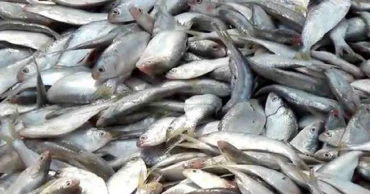hilsa fry
Two-month ban on ‘jatka’ catching begins this midnight
A two-month ban on catching 'jatka' (hilsa fry less than 9 inches or 23 centimetres in length) from March 1 to April 30 will begin in five hilsa sanctuaries across the country on Tuesday midnight.
To increase the production of hilsa, the government has imposed the ban in the Padma-Meghna sanctuary under Chandpur, Shariatpur, Laxmipur, Barishal and Bhola districts, said Golam Mehedi, Chandpur district fisheries officer.
Seventy kilometers sanctuary of Meghna in Sadar, Haimchar, Matlab North and Matlab South upazilas of the district is also under the restriction.
Besides, the government will provide 40 kgs of rice to 44,035 fishermen during the period, he said.
District taskforce committee has taken all necessary steps to stop netting jatka.
2 years ago
Bangladesh’s hilsa net looks to get bigger; 5.45 lakh mts output likely next year
The 22-day ban on catching hilsa is expected to yield a very good result as huge mother-hilsas have laid eggs during the period.
Experts said the hilsa production may hit 5.45 lakh metric tonnes if the government takes effective measures for conserving jatka (Hilsa fry). Dr Mohammad Anisur Rahman, a hilsa researcher and chief scientific officer at the Bangladesh Fisheries Research Institute, said, “Hilsas lay eggs round the year but mother hilsas come to rivers from sea and lay eggs during the ban period and then go back to the sea. So, it’s very important to ensure the uninterrupted movement of mother hilsas from the sea to rivers.”
Read: Coast guards seize 6.38 cr meters nets, 9,832 kgs Hilsa during ban period “During the breeding period, a mother hilsa usually releases 10-12 lakh eggs and this year, the new moon on the lunar phase occurred on October 6 while the full moon appeared on October 20 which is believed to be the right time of laying eggs. So, we’re getting the results from the ban,” he said. Dr Anisur also suggested taking steps to ensure the uninterrupted movement of mother hilsas from the sea to rivers and their safe spawning during the peak breeding season, stopping sand lifting from rivers and restricting hilsa netting during the ban period. According to a survey, this year 51.7 percent of mother hilsas laid eggs, setting a new record as it is .5% more than the previous year, he said.
Read Hilsa Ilisha: The National Fish and Silver Pride of Bangladesh
4 years ago


